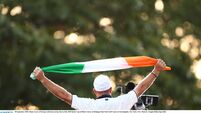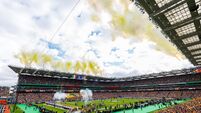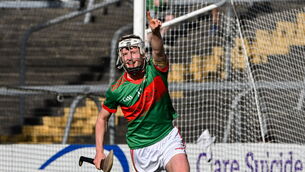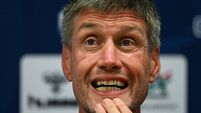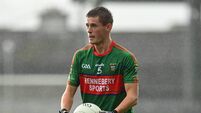Kieran Shannon: As Mayo cast off old fears, Dublin must remind rivals of the hierarchy
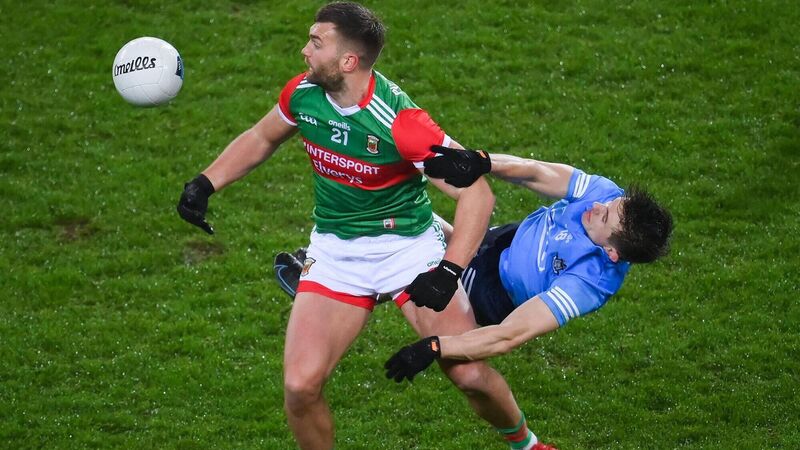
Mayo's Aidan O'Shea shrugs off Dublin's Michael Fitzsimons of Dublin during the Allianz Football League Division 1 match between the sides at Croke Park last weekend. Picture: Stephen McCarthy/Sportsfile
Back when Kilkenny were out in front of everyone else in hurling and Tipperary were the best of the rest, there was a term they sometimes used heading into any league game against Galway who they obviously perceived as the best — or at least the most dangerous — of the rest of the rest: Remind them of the hierarchy here.
For the most part they did. From Liam Sheedy’s first year in charge when they would face a Loughnane-led Galway in the league final up to the same two counties meeting in the league decider 10 years later, Tipp only lost twice in 13 encounters against the Tribesmen. Even in a year like 2010 when Galway won the league, Tipp had beaten them well earlier that spring, something that gave them a small but decisive edge when they would pip Galway later that summer en route to winning it all.
It was a mentality, whatever about a maxim, that Kilkenny lived by, especially whenever they came across Tipp themselves at any time of the year. It’s one of the reasons why though Paudie Maher retires having won three All-Ireland finals against Kilkenny, he also finished without winning a league medal despite having featured in five finals: outside of 2017 when Galway served notice that the old hierarchy would no longer apply for them that year against Tipp or anyone else, Maher’s other four losses were all against Cody’s Cats who could never get enough of trying to keep Tipp in their place.
For the longest time the Dublin footballers brought that mindset to the national league, especially any time they found Mayo in the other corner. Even in 2019 when Mayo would go on to win that spring competition and raise some rare national silverware in Croke Park, Dublin had earlier in the campaign reminded them of the hierarchy of their relationship, dismissing them 1-12 to 0-7, a psychological marker that would have some resonance six months later when Dublin would enjoy their most convincing championship win over Mayo.
For all the other epic championship contests Mayo had with — and gave — Dublin over the past decade, being far more competitive against them at the end of the year than they’d be near the start, some of those league patterns would hold. Invariably in the league Mayo would be out-goaled (2013: 2-0 and 2-0. 2014: 3-2. 2015: 2-0. 2016: a rare 0-0. 2017: 1-0. 2018: 2-0. 2019: 1-0. 2020: 1-0), a trend that would often repeat itself in their last game of the year in Croke Park, often against Dublin 2012 v Donegal: 2-0. 2013: 2-1. 2014 v Kerry: 3-3. 2015: 2-1, 3-1. 2016: 2-0, 1-1. 2017: 1-1. 2019: 3-1. 2020: 2-0. 2021 v Tyrone: 2-0.
That was one of the most significant and satisfying things about last Saturday night from a Mayo perspective, beyond following up on last August’s win and establishing what the new hierarchy in this relationship might be: they beat Dublin by the kind of scoreline (2-11 to 0-12) that we — and the two teams — are so accustomed to Dublin beating Mayo by. It was like the 2020 Covid All-Ireland in reverse, down to Mayo manufacturing a fisted goal — or a team goal as the Dubs used to term it during Jason Sherlock’s stint as team coach — not dissimilar to how Con O’Callaghan worked a fisted goal that strange December night.
July — it’s strange not say September — is still a long way away for Mayo and everyone else but deep down that is something that James Horan has to be mindful of as he continues to go so well about this Mayo project: can he construct a defence that maintain a clean sheet on the biggest day of all? It’s how virtually every other county has made their breakthrough ever since he played his last game for the county 20 years ago: Armagh in 2002, Tyrone in 2003, Cork in 2010, Donegal in 2012, Kerry in 2014, Tyrone in 2021. Or at the very least you cannot be outgoaled. Only Tyrone in 2005 and Kerry in 2009 during that time have been outgoaled on the last day of the year and still ended up walking away with Sam.
There are a lot of parallels with this latest stint of Horan’s and his first time around the block as county manager.
In his first year each time he took a team that had exited the championship in the qualifiers the previous year and brought them to an All-Ireland semi-final after epic quarter-final wins (2011 v Cork, 2019 v Donegal) only for them to realise after game first halves that they’re quite a bit off the required level.
In his second year then he takes them to an All-Ireland final where they’re again game but lose by four points.
In his third year then they gets them back there, a side seemingly on a date with destiny, only to fall short again.
If that trend were to repeat itself, you’re looking at Mayo losing an epic All-Ireland semi-final this July in some mad place like Thurles or Cork when their concert season may have concluded.
Mayo played some terrific football in that 2014 league as well, putting up big scores on the likes of Cork (when that was still an achievement), Kerry, and Dublin. But already there are encouraging signs that Mayo are built to go even faster and longer with Horan refreshing and reinventing the project even better than he did in his previous fourth season.
Back in 2014, no real new player adequately raised their hand or were given their head: Jason Gibbons and Adam Gallagher each put together an impressive run of games at various stages that year but come the end of the championship the only real new face was an old one in the form of Tom Parsons. Last Saturday night Horan again gave a crop of new players their chance — Orme, Towey, Carney — consistent with the masterful job he has done blooding and blending in new players to go with and replace the old.
Just as significantly they’re leaking less goals. Even when Mayo played some scintillating football during that 2014 league, they were regularly giving up multiple goals, failing to keep a single clean sheet, and only once managing to concede less than two: ultimately that cost them that spring (giving up two goals to Derry in the semi-final) and that summer (giving up three to the O’Donoghue-Donaghy tandem in Limerick).
This year they’ve conceded only one goal in their opening three games. For sure, Robbie Hennelly has had to produce some heroics and there are questions over whether they have a shutdown full-back along the lines of a Chris Barrett or even a Ger Cafferkey in his 2012-13 pomp. But they have options and depth and a structure back there which, along with the dash of Ryan O’Donoghue and the imminent return of Cillian O’Connor, hints that this year they might finally outgoal a team in their last game of the year. We’ll know more after they play Armagh at ‘home’ in Roscommon next weekend, and then visit Tralee.
For Dublin Newbridge will help tell us if they’re on the road to nowhere. Whoever loses will likely be relegated, but it goes beyond even the league. Dublin may not be what they once were — they will not for instance retain the league title they shared with Kerry last year — but they are still the reigning Leinster champions. Lose, and they are not just looking at Division Two but they could allow Kildare to get notions that they could win Leinster this year.
They will hardly stand for that, as much as they might be a shadow of the team they’ve been and possibly will be once a Con O’Callaghan returns to the field.
They have slipped down the pecking order but surely there’s only so much they'll tolerate, so far they'll slide? Time to remind Kildare of their place in the hierarchy.


